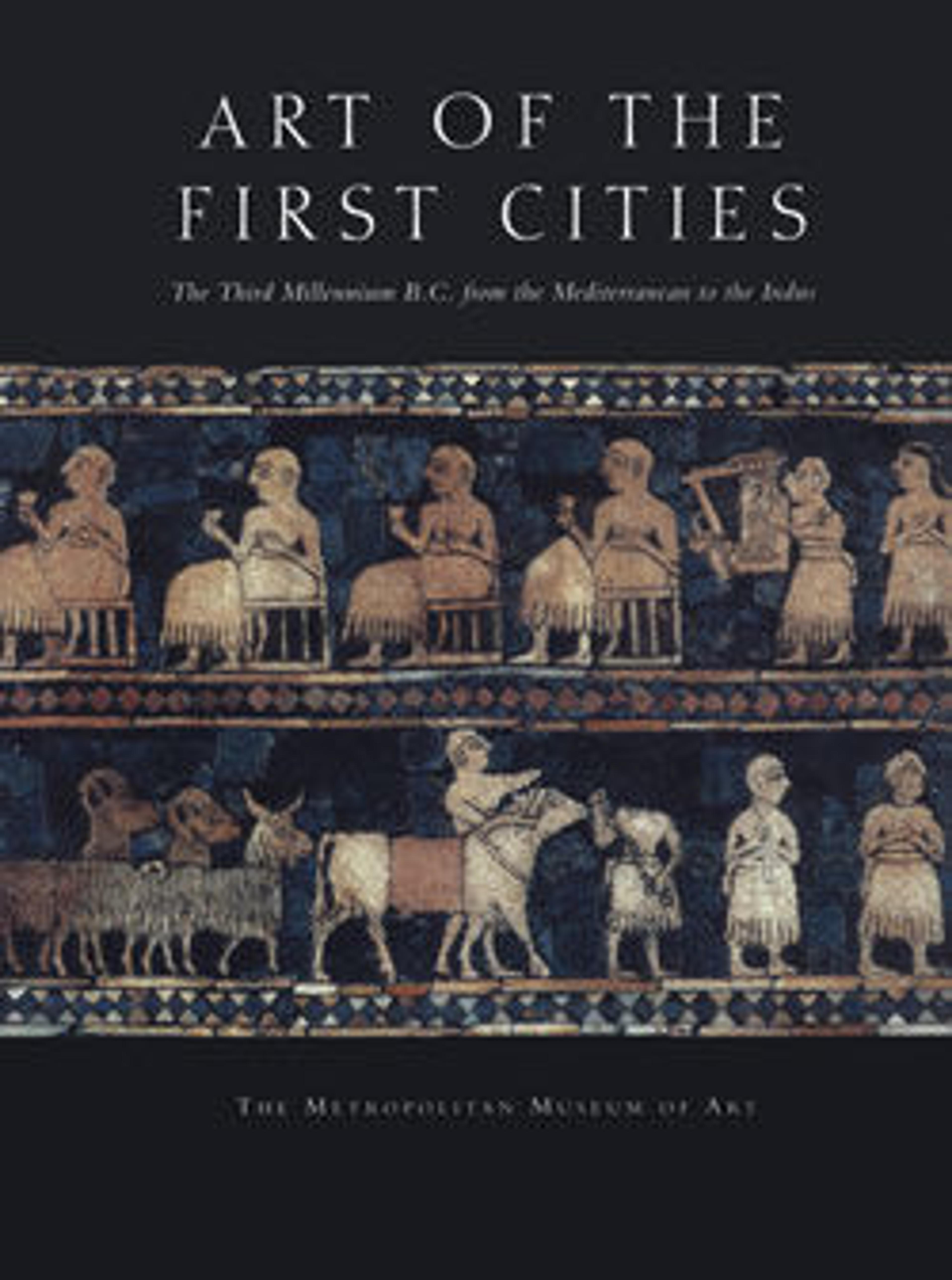Art of the First Cities: The Third Millennium B.C. from the Mediterranean to the Indus - The Metropolitan Museum of Art (original) (raw)

Aruz, Joan, ed., and Ronald Wallenfels, with essays by Hans J. Nissen, Donald P. Hansen, Holly Pittman, Joachim Marzahn, Karen L. Wilson, Béatrice André-Salvini, Julian Reade, Jean-Claude Margueron, Nadja Cholidis, Paolo Matthiae, Glenn M. Schwartz, Anne Porter, Thomas McClellan, Giorgio Buccellati, Marilyn Kelly-Buccellati, James P. Allen, Claus Reinholdt, Eleni Drakaki, Lena Papazoglou-Manioudaki, Oscar White Muscarella, Elena Izbitser, Yuri Piotrovsky, D. T. Potts, Jean-François de Lapérouse, Paul Collins, Joan Aruz, Maurizio Tosi, C. C. Lamberg-Karlovsky, Elisabetta Valtz Fino, Jonathan Mark Kenoyer, Jean M. Evans, Béatrice André-Salvini, Piotr Michalowski, Beate Salje, and Ira Spar
Choice Outstanding Academic Title (2005)
This title is out of print.
Our civilization is rooted in the forms and innovations of societies that flourished in the distant lands of Western Asia more than six thousand years ago. These earliest societies, established millennia before the Greco-Roman period, extended from Egypt to India. The earliest among them was the region known to the ancients as Mesopotamia, located between the Tigris and the Euphrates Rivers and occupying what is today Iraq, northeastern Syria, and southeastern Turkey. In Mesopotamia arose the first cities, believed by their inhabitants to be the property of the gods, who granted kings the power to bring prosperity to the people. Here urban institutions were invented and evolved. The need to record and manage the distribution and receipt of goods led to the invention of writing, monumental architecture in the form of temples, and palaces were created, and the visual arts flowered in the service of religion and royalty. These extraordinary innovations profoundly affected surrounding areas in Anatolia, Syria-Levant, Iran, and the Gulf, and Mesopotamia was in turn influenced by its neighbors. As Mesopotamia turned to outlying lands for such rare and precious materials as lapis lazuli, carnelian, diorite, gold, silver, and ivory, these regions were linked by networks of trade that encouraged cultural exchange.
This volume, which accompanies a major exhibition at The Metropolitan Museum of Art, New York, explores the artistic achievements of the era of the first cities in both the Mesopotamian heartland and across the expanse of western Asia. More than fifty experts in the field have contributed entries on individual works of art and essays on a wide range of subjects. The first book that encompasses a study of the entire region during a single period, this publication break new ground in particular in its examination of trade and interconnections. In texts that will be of interest to both specialists and the general public, the social and historical context of the art of the first cities is explored. Many objects presented display the pure style of Mesopotamia, others from outlying regions adapt from them a corpus of forms and images, and still others embody vital regional styles. Included are reliefs celebrating the accomplishments of kings and the pastimes of the elite; votive statues representing royal and other privileged persons; animal sculptures; and spectacular jewelry, musical instruments, and games found in tombs where kings, queens, and their servants were buried.
The volume opens with a focus on the cities of southern Mesopotamia, among them Uruk and Nippur; the cities of the north, Mari and Ebla; and the Akkadian Dynasty. Next follow sections devoted to art and interconnections from the Mediterranean to the Indus, in which Egypt, the Aegean and western Anatolia, the North Caucasus, the Gulf, Iran, and the Indus area are studied. Finally, a section on literature and legacy treats the invention of cuneiform writing and the heritage of Mesopotamian literature and ideas.
More than five hundred reproductions of the works in the exhibition as well as comparative materials are included in the lavish illustrations, and landscape photographs offer a sense of place. Maps, a chronology, a bibliography, and an index are provided.
Proto-Elamite
ca. 3100–2900 BCE
Greek, South Italian, Tarentine
ca. 300 BCE
Sumerian
2900–2700 BCE
Sumerian
ca. 2900–2600 BCE
Sumerian
ca. 2600–2500 BCE
ca. 2300–2000 BCE
Akkadian
ca. 2250–2150 BCE
Hurrian
ca. 2200–2100 BCE
ca. mid- to late 3rd millennium BCE
Bactria-Margiana Archaeological Complex
ca. late 3rd–early 2nd millennium BCE
Neo-Sumerian
ca. 2090 BCE
Neo-Sumerian
ca. 2080 BCE
A slider containing
5
items.
Press the down key to skip to the last item.
- Timeline of Art History | Essay
Ebla in the Third Millennium B.C.
- Timeline of Art History | Essay
Mesopotamian Deities
- Timeline of Art History | Essay
The Origins of Writing
- Timeline of Art History | Essay
Art of the First Cities in the Third Millennium B.C.
- Timeline of Art History | Essay
Uruk: The First City
- Timeline of Art History | Essay
Mesopotamian Creation Myths
- Timeline of Art History | Essay
Animals in Ancient Near Eastern Art
Aruz, Joan, Ronald Wallenfels, and Metropolitan Museum of Art (New York, N.Y.), eds. 2003. Art of the First Cities: The Third Millennium B.C. from the Mediterranean to the Indus. New York : New Haven: Metropolitan Museum of Art : Yale University Press.